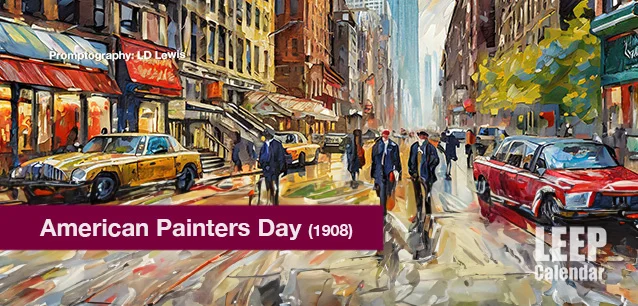 AD
AD
Today is: October 28
Scroll to explore events active on this date.
Additional Events on LEEP
LEEP INK FEATURES

August? Absolutely!
In August, we live through the Dog Days of Summer. It's hot and often humid, and those who can leave for better climates do. Down south, winter is in full force. August is also known as "the ...

In The Heat of July: July 2025 Events
Is it hot enough (or cold enough if you're below the equator) for you yet? There is actually a day for that! Like every month, I pick a diverse collection of events you may or may not know about. This ...

May Blooms: Events in May 2025
Along with October, May is one of the most densely packed months of the year. It's before the summer humidity and the last whole month of the school year. The weather is warming in t...
About American Painters Day
Culture & Art , Hobby
United States
Ends: Feb 03, 2024
DESCRIPTION:
American Painters Day celebrates the rich and diverse history of American painting. Its connection to The Eight, a group of early 20th-century artists, underscores the day's significance in highlighting the evolution of American art.
The Eight, consisting of Arthur B. Davies, William J. Glackens, Robert Henri, Ernest Lawson, George Luks, Maurice Prendergast, Everett Shinn, and John Sloan, were pivotal figures in the American art scene. They opened an exhibition at the Macbeth Gallery in New York City on February 3, 1908, marking a momentous occasion in the history of American art. This exhibition challenged the artistic norms of the era, paving the way for modern American painting.
These artists were united not by a single style but by their shared desire for artistic independence and their opposition to the academic constraints imposed by institutions like the National Academy of Design. Their work varied widely in subject matter and technique, encompassing urban realism, impressionistic landscapes, and scenes of everyday life reflecting a broader shift in American art, moving away from traditional European influences towards a more varied and uniquely American perspective.
The 1908 exhibition at the Macbeth Gallery was significant for rejecting the established art world's standards. It showcased a form of realism that was starkly different from the idealized and polished works that were popular at the time. The exhibition's success led to increased recognition of these artists and helped to inspire future generations of American painters.
American Painters Day, in association with The Eight, serves as a reminder of the importance of artistic freedom and innovation. It celebrates the contributions of American artists to the global art scene and encourages appreciation for the diverse styles and themes that characterize American painting.CONSIDER THESE 9 FAMOUS AMERICAN PAINTERS
Norman Rockwell (1894–1978): Known for his poignant and romantic portrayals of American life, Rockwell's most famous work is arguably "Freedom from Want" (1943), part of the Four Freedoms series, which depicts a family gathered around a table for a holiday meal.
Jackson Pollock (1912–1956): A leading figure in abstract expressionism, Pollock's most celebrated work is "No. 5, 1948," known for its distinctive style of drip painting.
Georgia O'Keeffe (1887–1986): Renowned for her large-scale, close-up paintings of flowers, O'Keeffe's "Jimson Weed/White Flower No. 1" (1932) is one of her most famous works, exemplifying her unique perspective on natural forms.
Andy Warhol (1928–1987): A leading figure in the pop art movement, Warhol is best known for his work "Campbell's Soup Cans" (1962), a series of thirty-two canvases of iconic soup cans reflecting consumer culture.
Edward Hopper (1882–1967): Skilled at depictions of solitude in contemporary American life, Hopper's most famous painting is "Nighthawks" (1942), portraying people sitting in a downtown diner late at night.
Jean-Michel Basquiat (1960–1988): Emerging from the graffiti scene in New York City, Basquiat's most acclaimed work is "Untitled" (1982), known for its raw, emotive style and commentary on African-American identity.
Mary Cassatt (1844–1926): An American painter and printmaker, Cassatt is well known for "The Child's Bath" (1893), which displays her signature focus on the intimate bonds between mothers and children.
Grant Wood (1891–1942): Best known for his paintings depicting the rural American Midwest, Wood's most famous work is "American Gothic" (1930), showing a farmer standing beside a woman, presumed to be his daughter, in front of a gothic-style house.
Mark Rothko (1903–1970): Renowned for his contributions to abstract expressionism, Rothko's most notable works are his color field paintings, particularly "Orange, Red, Yellow" (1961), characterized by large blocks of color.
The legacy of The Eight lives on as their work and their fight for artistic independence continue to inspire contemporary artists. American Painters Day, in this context, is not just about honoring past artists but also about acknowledging American art's ongoing evolution and vitality.
VIDEOS
SUPPORTING DOCUMENTS
Currently, this event does not have supporting documents.
ADDITIONAL IMAGES
Currently, this event does not have supporting images.
Where would you like to go now?
 AD
AD


/footer-logo.svg)
